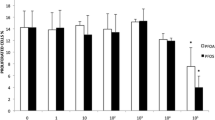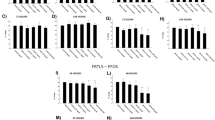Abstract
Purpose
Perfluorinated chemicals are widespread pollutants persistent in the environment with links to some major health issues. The two main compounds, perfluoro-octanoic acid (PFOA) and perfluoro-alkyl sulphonate (PFOS), were recently classified as carcinogenetic and thus their use has been restricted. Short-chain PFCs were recently developed as an alternative, but no data regarding the possible endocrine toxicities of these compounds are available. Aim of this study was to investigate whether short-chain PFCs could jeopardize thyroid cell viability and/or interfere with the functional effect TSH.
Methods
Fisher rat thyroid line-5 (FRTL-5) was treated with increasing concentrations of PFOA, PFOS, perfluorobutanesulfonic acid (PFBS), perfluorobutanoic acid (PFBA), pentafluoropropionic anhydride (PFPA), perfluoropentanoic acid (PFPeA) to evaluate modifications in cell viability and TSH-stimulated cAMP production.
Results
Neither long nor short-chain PFCs affected cell viability (apart from PFOS 100 µM), or interfered with cAMP production.
Conclusions
The results of the present study demonstrate for the first time that short-chain PFCs have no acute cytotoxic effect on thyroid cells in vitro and that cAMP production is not modulated by any of the tested PFCs.



Similar content being viewed by others
References
Austin ME, Kasturi BS, Barber M, Kannan K, MohanKumar PS, MohanKumar SM (2003) Neuroendocrine effects of perfluorooctane sulfonate in rats. Environ Health Perspect 111:1485–1489
Lau C, Anitole K, Hodes C, Lai D, Pfahles-Hutchens A, Seed J (2007) Perfluoroalkyl acids: a review of monitoring and toxicological findings. Toxicol Sci 99:366–394
Negri E, Metruccio F, Guercio V, Tosti L, Benfenati E, Bonzi R, La Vecchia C, Moretto A (2017) Exposure to PFOA and PFOS and fetal growth: a critical merging of toxicological and epidemiological data. Crit Rev Toxicol 47:482–508
Apel P, Angerer J, Wilhelm M, Kolossa-Gehring M (2017) New HBM values for emerging substances, inventory of reference and HBM values in force, and working principles of the German Human Biomonitoring Commission. Int J Hyg Environ Health 220:152–166
Hekster FM, Laane RW, de Voogt P (2003) Environmental and toxicity effects of perfluoroalkylated substances. Rev Environ Contam Toxicol 179:99–121
Domingo JL (2012) Health risks of dietary exposure to perfluorinated compounds. Environ Int 40:187–195
Coperchini F, Awwad O, Rotondi M, Santini F, Imbriani M, Chiovato L (2017) Thyroid disruption by perfluorooctane sulfonate (PFOS) and perfluorooctanoate (PFOA). J Endocrinol Invest 40:105–121
Secretariat of the Stockholm Convention: The new POPs under the Stockholm Convention (2011). http://chm.pops.int/Implementation/NewPOPs/ThenewPOPs/tabid/672/Default.aspx
Fact sheet: PFOA and PFOS Drinking Water Health Advisories. EPA 800-F-16-003. https://www.epa.gov/ground-water-and-drinking-water/supporting-documents-drinking-water-health-advisories-pfoa-and-pfos
Wang Z, Cousins IT, Scheringer M, Hungerbühler K (2013) Fluorinated alternatives to long-chain perfluoroalkyl carboxylic acids (PFCAs), perfluoroalkane sulfonic acids (PFSAs) and their potential precursors. Environ Int 60:242–248
Mudumbi JBN, Ntwampe SKO, Matsha T, Mekuto L, Itoba-Tombo EF (2017) Recent developments in polyfluoroalkyl compounds research: a focus on human/environmental health impact, suggested substitutes and removal strategies. Environ Monit Assess 189:402
Buck RC, Franklin J, Berger U, Conder JM, Cousins IT, de Voogt P, Jensen AA, Kannan K, Mabury SA, van Leeuwen SP (2011) Perfluoroalkyl and polyfluoroalkyl substances in the environment: terminology, classification, and origins. Integr Environ Assess Manag 7:513–541
Wang T, Wang P, Meng J, Liu S, Lu Y, Khim JS, Giesy JP (2015) A review of sources, multimedia distribution and health risks of perfluoroalkyl acids (PFAAs) in China. Chemosphere 129:87–99
Briefing GB (2012) Perfluorinated chemicals: a persistent problem. M.B. Europe, North America. http://chemicalwatch.com/11013/perfluorinated-chemicals-a-persistent-problem
Vongphachan V, Cassone CG, Wu D, Chiu S, Crump D, Kennedy SW (2011) Effects of perfluoroalkyl compounds on mRNA expression levels of thyroid hormone-responsive genes in primary cultures of avian neuronal cells. Toxicol Sci 120:392–402
Coperchini F, Pignatti P, Lacerenza S, Negri S, Sideri R, Testoni C, de Martinis L, Cottica D, Magri F, Imbriani M, Rotondi M, Chiovato L (2015) Exposure to perfluorinated compounds: in vitro study on thyroid cells. Environ Sci Pollut Res Int 22:2287–2294
Leonard RC, Kreckmann KH, Sakr CJ, Symons JM (2008) Retrospective cohort mortality study of workers in a polymer production plant including a reference population of regional workers. Ann Epidemiol 18:15–22
Barry V, Winquist A, Steenland K (2013) Perfluorooctanoic acid (PFOA) exposures and incident cancers among adults living near a chemical plant. Environ Health Perspect 121:1313–1318
Steenland K, Woskie S (2012) Cohort mortality study of workers exposed to perfluorooctanoic acid. Am J Epidemiol 176:909–917
Olsen GW, Zobel LR (2007) Assessment of lipid, hepatic, and thyroid parameters with serum perfluorooctanoate (PFOA) concentrations in fluorochemical production workers. Int Arch Occup Environ Health 81:231–246
Pirali B, Negri S, Chytiris S, Perissi A, Villani L, La Manna L, Cottica D, Ferrari M, Imbriani M, Rotondi M, Chiovato L (2009) Perfluorooctane sulfonate and perfluorooctanoic acid in surgical thyroid specimens of patients with thyroid diseases. Thyroid 19:1407–1412
Li Y, Cheng Y, Xie Z, Zeng F (2017) Perfluorinated alkyl substances in serum of the southern Chinese general population and potential impact on thyroid hormones. Sci Rep 7:43380
Melzer D, Rice N, Depledge MH, Henley WE, Galloway TS (2010) Association between serum perfluorooctanoic acid (PFOA) and thyroid disease in the U.S. National Health and Nutrition Examination Survey. Environ Health Perspect 118:686–692
Knox SS, Jackson T, Frisbee SJ, Javins B, Ducatman AM (2011) Perfluorocarbon exposure, gender and thyroid function in the C8 Health Project. J Toxicol Sci 36:403–410
Winquist A, Steenland K (2014) Perfluorooctanoic acid exposure and thyroid disease in community and worker cohorts. Epidemiology 25:255–264
Chang SC, Thibodeaux JR, Eastvold ML, Ehresman DJ, Bjork JA, Froehlich JW, Lau C, Singh RJ, Wallace KB, Butenhoff JL (2008) Thyroid hormone status and pituitary function in adult rats given oral doses of perfluorooctanesulfonate (PFOS). Toxicology 243:330–339
Huang M, Jiao J, Zhuang P, Chen X, Wang J, Zhang Y (2018) Serum polyfluoroalkyl chemicals are associated with risk of cardiovascular diseases in national US population. Environ Int 119:37–46
Lee JH, Lee CK, Suh CH, Kang HS, Hong CP, Choi SN (2017) Serum concentrations of per- and poly-fluoroalkyl substances and factors associated with exposure in the general adult population in South Korea. Int J Hyg Environ Health 220:1046–1054
Dumont JE, Lamy F, Roger P, Maenhaut C (1992) Physiological and pathological regulation of thyroid cell proliferation and differentiation by thyrotropin and other factors. Physiol Rev 72:667–697
Jin S, Hornicek FJ, Neylan D, Zakarija M, McKenzie JM (1986) Evidence that adenosine 3′,5′-monophosphate mediates stimulation of thyroid growth in FRTL5 cells. Endocrinology 119:802–810
Vassart G, Dumont JE (1992) The thyrotropin receptor and the regulation of thyrocyte function and growth. Endocr Rev 13:596–611
Weiss SJ, Philp NJ, Grollman EF (1984) Iodide transport in a continuous line of cultured cells from rat thyroid. Endocrinology 114:1090–1098
Avvedimento VE, Tramontano D, Ursini MV, Monticelli A, Di Lauro R (1984) The level of thyroglobulin mRNA is regulated by TSH both in vitro and in vivo. Biochem Biophys Res Commun 122:472–477
Ambesi-Impiombato FS, Parks LA, Coon HG (1980) Culture of hormone-dependent functional epithelial cells from rat thyroids. Proc Natl Acad Sci USA 77:3455–3459
Dremier S, Vandeput F, Zwartkruis FJ, Bos JL, Dumont JE, Maenhaut C (2000) Activation of the small G protein Rap1 in dog thyroid cells by both cAMP-dependent and -independent pathways. Biochem Biophys Res Commun 267:7–11
Santini F, Vitti P, Ceccarini G, Mammoli C, Rosellini V, Pelosini C, Marsili A, Tonacchera M, Agretti P, Santoni T, Chiovato L, Pinchera A (2003) In vitro assay of thyroid disruptors affecting TSH-stimulated adenylate cyclase activity. J Endocrinol Invest 26:950–955
Wen LL, Lin LY, Su TC, Chen PC, Lin CY (2013) Association between serum perfluorinated chemicals and thyroid function in U.S. adults: the National Health and Nutrition Examination Survey 2007–2010. J Clin Endocrinol Metab 98:E1456–E1464
Dong H, Curran I, Williams A, Bondy G, Yauk CL, Wade MG (2016) Hepatic miRNA profiles and thyroid hormone homeostasis in rats exposed to dietary potassium perfluorooctanesulfonate (PFOS). Environ Toxicol Pharmacol 41:201–210
Song M, Kim YJ, Park YK, Ryu JC (2012) Changes in thyroid peroxidase activity in response to various chemicals. J Environ Monit 14:2121–2126
Kim MJ, Moon S, Oh BC, Jung D, Ji K, Choi K, Park YJ (2018) Association between perfluoroalkyl substances exposure and thyroid function in adults: a meta-analysis. PLoS One 13:e0197244
Ballesteros V, Costa O, Iñiguez C, Fletcher T, Ballester F, Lopez-Espinosa MJ (2017) Exposure to perfluoroalkyl substances and thyroid function in pregnant women and children: a systematic review of epidemiologic studies. Environ Int 99:15–28
Mariussen E (2012) Neurotoxic effects of perfluoroalkylated compounds: mechanisms of action and environmental relevance. Arch Toxicol 86:1349–1367
Author information
Authors and Affiliations
Corresponding author
Ethics declarations
Conflict of interest
The authors declare that they have no conflict of interest.
Ethical approval
This article does not contain any studies with human participants or animals performed by any of the authors.
Informed consent
No informed consent.
Additional information
Publisher's Note
Springer Nature remains neutral with regard to jurisdictional claims in published maps and institutional affiliations.
Rights and permissions
About this article
Cite this article
Croce, L., Coperchini, F., Tonacchera, M. et al. Effect of long- and short-chain perfluorinated compounds on cultured thyroid cells viability and response to TSH. J Endocrinol Invest 42, 1329–1335 (2019). https://doi.org/10.1007/s40618-019-01062-1
Received:
Accepted:
Published:
Issue Date:
DOI: https://doi.org/10.1007/s40618-019-01062-1




